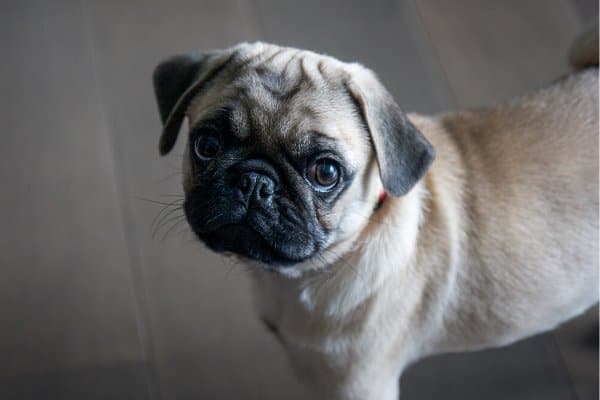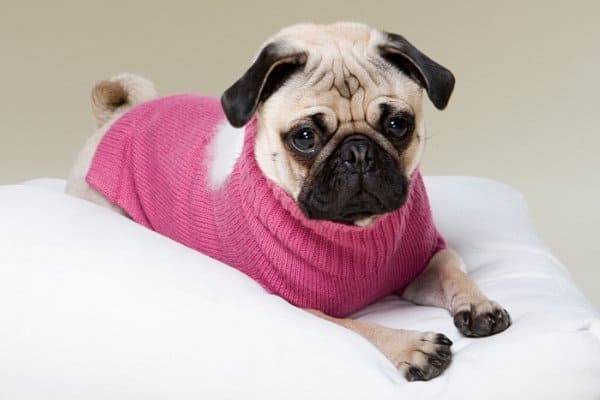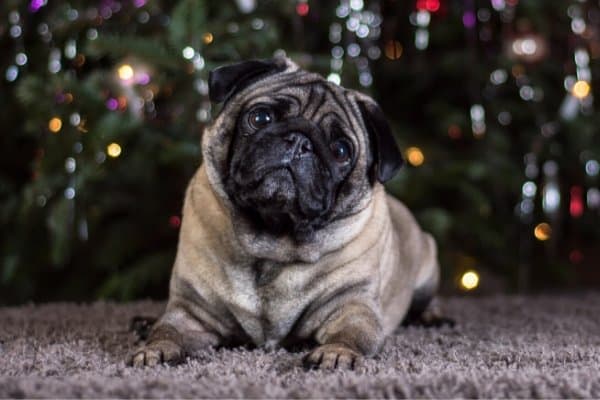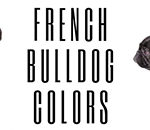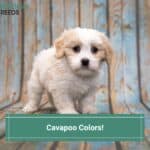We can’t deny that the issue of dog coat color and the genetics which are responsible for producing all of the various colors, shades, patterns, and combinations can be very confusing.
When you look at the standard colors for a certain breed versus the colors that are actually available, you’re often left scratching your head, more puzzled than you were before.
What about the 28th most popular breed in America…the delightful, incredibly cute Pug? A quick glance at the American Kennel Club’s (AKC) description of the Pug breed will tell you that Pugs come in three colors: Silver, Apricot-Fawn, and Black.
However, if you examine the AKC’s official breed standard closely, you’ll find that only fawn and black are listed.
See what we mean about scratching your head?
What colors do Pugs come in? While many colors such as Blue, Chocolate, and White are available as well as patterns such as Merle, Brindle, and Pied, the AKC only recognizes two colors for the show ring: Fawn and Black. Many variations exist in the Fawn color which can range from Light Cream to Apricot.
Let’s take a closer look at the various common colors and shades that Pugs come in and the not-so-common (rare) variations that can be found today.
Most Common Pug Colors
Before we look at the most common colors found among Pugs today, we feel that we should clarify the AKC’s stance on Pug color.
AKC Breed Standard
In the AKC show ring, only two colors, fawn and black are allowed. Any other color is considered to be a disqualification. However, while black is black, fawn covers many shades and hues from light to medium cream.
Pugs who are actually silver or apricot (both of which can be quite similar to pure fawn depending on the shade) can be registered as being fawn and therefore are eligible to compete, or they can be listed as an alternative color which would state their true color but be a disqualification in the show ring.
So, technically, yes, the AKC only permits two colors in the show ring but makes it possible for both silver and apricot-fawn Pugs to be registered as fawn.
Other Clubs’ Breed Standards
The Fédération Cynologique International (FCI), which you may know as the World Canine Organization, allows for four Pug colors: fawn, black, silver, and apricot. The Kennel Club of the UK (KC) does the same.
The Canadian Kennel Club (CKC), however, only allows for fawn which can include both light and dark shades, silver-fawn, and black.
Fawn
Nearly two-thirds of all Pugs are fawn in color. The fawn color can range from a very light cream to a medium cream to various shades of gold, or have silver undertones on a cream background. Tones of very light orange or even subtle hints of red are sometimes noted in this most common color, but a rich cream color is preferable.
While many fawn Pugs are mostly uniform in color, some may have a combination of fawn shades on their body with some areas being much lighter or darker than others.
Black
Black Pugs should be a uniform, deep black over the entire body. Occasionally a small white marking will be present on the chest and even more rarely one or more paws will be white.
This is due to the presence of a parti-factor gene and is a major fault in the show ring. This white coloration is possible in all coat colors but is particularly noticeable in black Pugs.
Pugs who have two black color genes appear to have a rich, bluish-black color in sunlight and will always produce black puppies because black is a dominant color.
Pugs with one black color gene and one fawn color gene will be black as well but will have more of a rusty or brown sheen to the coat in sunlight. They can produce either fawn or black puppies depending on what color genes are contributed by their mate.
Silver and Silver-Fawn
As you might expect, silver Pugs have a lovely gray sheen to their coats which can be medium to dark in color. The silver-fawn color is very light and is a variation of fawn. Both colors may be registered as fawn if the dog is able to be registered and the owner so chooses.
Apricot and Apricot-Fawn
Apricot is a deeper orange color than fawn. At the owner’s discretion, a Pug that is somewhere in between a light fawn and a deep apricot may be labeled as an apricot-fawn. Apricot Pugs often have a patch of lighter color on the chest area or elsewhere on the body, particularly above the facial mask.
Owners of an AKC-registrable Pug may choose to register an apricot or apricot-fawn as a fawn or as an alternative color.
Special Markings
Mask and Ears
All non-black Pugs should display a deep black facial mask beginning underneath the chin, covering the muzzle, and extending over the eyes. The ears also should be black.
Thumbprint
A dark thumbprint (darkened patch of color) on the forehead and a dark trace (line of darker color on the back) are highly desirable but are not seen on all Pugs. The AKC prefers all markings to be intense and as black as possible.
Smuttiness
Some Pugs may display what is known as smuttiness. This term refers to an overabundance of black hairs intermingled with a lighter colored coat.
A small sprinkling of black hairs here and there on a light-colored dog is normal and does not qualify as smuttiness, but if it occurs to the extent that the coat appears to be a different color, the dog is said to display smuttiness.
Smuttiness is considered to be a fault in the show ring and points will be deducted from the overall score. It is not, however, a disqualification.
Rare Pug Colors
If you take the time to view a few Pug breeders’ websites, you’ll no doubt stumble across some colors that up till now have not been associated with Pugs. Here are some you’ll likely find:
- White
- Brindle
- Blue
- Blue-Fawn
- Merle
- Blue-Merle
- Chocolate
- Panda
- Black and Tan
- Pink
- Chinchilla
- Pied
- Platinum
While the newer, often flashy, colors are lovely, keep in mind that they are not in a purebred Pug’s bloodline. In order to produce these colors, at some point in time a different breed was added to the mix.
A genetic analysis (like this one on Amazon) would verify that these various colored Pugs are likely not purebred.
Breeders selling uniquely colored Pugs are actively, intentionally breeding away from the breed standards and some standard Pug characteristics may be lost in the process. Keep all this in mind if you are looking for a quality, purebred Pug who looks 100% like a Pug.
Do Pugs Change Color As They Age?
It is not uncommon for a non-black Pug to experience a lightening or darkening of the coat color as they mature, especially during the first year. The apricot color may not be present at birth but may develop as the puppy grows.
The degree of smuttiness often changes as well, either fading away or deepening over time. The black on the facial mask and ears may intensify as the puppy nears adulthood. A dark trace may lighten with time or become more pronounced.
With black Pugs, the senior years often bring some gray hairs, especially around the muzzle.
Related Questions
Does Pug Coat Color Affect Temperament?
While some people may claim that their black Pug is more energetic and engaging than their fawn Pug, their observations are based merely on their dogs’ individual personalities, not the color of their coat. There is no known genetic link tying coat color to temperament.
Does Pug Coat Color Affect Shedding?
No. The color of a dog’s coat has nothing to do with shedding tendencies. Shedding is a breed-specific trait not dependent on color. Most Pug’s have a double coat which sheds moderately.
However, some black Pugs only have a single coat. This single coat won’t produce as much shed hair as a double coat. So, it is coat type, not color, that is responsible for shedding amounts.


